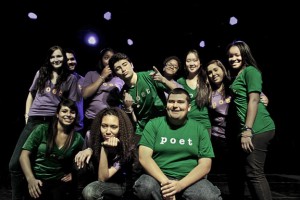Dancers and poets team up to go beyond expression
Can a poem be danced? Can the human body capture the dips and beats of a Shakespearean sonnet? Can the body reflect the expressive, sometimes inflammatory voice of the spoken word?
These questions, and many more, were explored Monday night in the Visions & Voices event, Dancing the Poem.
Organized by USC faculty members Carol Muske-Dukes and Margo Apostolos, Dancing the Poem explored the relationship between poetry and dance, and between spoken and written poetry. The event featured the Get Lit Players, an award-winning teen poetry troupe from Los Angeles, in collaboration with the Poetry Dance Troupe from USC’s School of Theatre.
A surprisingly young and diverse crowd appeared at the event, including students from two schools of the USC Family of Schools, Foshay Learning Center and Manual Arts High School.
With an obvious nod to West Side Story, the performance began with the audience in the midst of a furious gang battle between the “Page Poets” and the “Stage Poets.” The Stage Poets fiercely advocate for the spoken word, also known as slam poetry, while the Page Poets swear by classic, written poetry. With tensions boiling high and exclamations such as “Nobody remembers what hasn’t been written,” from one Page Poet, the battle for linguistic superiority begins.
Each poem was interpreted by dancers moving behind the poet as he or she read. Dancers glided across the stage in a variety of styles that included hip-hop, modern, salsa and even a smattering of tap dance. These diverse styles reflected the radically different poems read by each poet and by each school of poetry.
As each side took turns reading poems, no piece was the same as another. The poems ranged from short to extensive to quiet to explosive, producing a wide variety of reactions from the young audience. Some of the more culturally charged spoken-word poems drew quite a number of whoops.
Often, the performers took their pieces and transformed them into a memorable experience. Readings of “The Love Song of J. Alfred Prufrock” by T.S. Eliot and “I’m a Rapper” by Sekou “tha Misfit” were particularly stirring because of the speakers’ ability to bring the words to life with passion and enthusiasm.
The poetry and the dance seemed to flow into each other during certain pieces, while in others the two seemed to merely coexist. A tap dance interpretation of Gwendolyn Brook’s famous poem “We Real Cool” was particularly original in its ability to beat out the lines of the poem with surprising volume and rhythm.
This performance inspired many questions about what poetry is and even about what poetry is becoming. As lines between the old and new, traditional and contemporary and rap and poetry begin to blur, what can we regard as “real” poetry? With its clear hip-hop and rap influences, is spoken word or slam poetry in serious danger of making poetry cool?
Can the rhythm of a poem really be translated with a dancer’s leaps and bounds?
Many of these questions were probed in the fantastic finale of “Let America Be America Again,” a poem by Langston Hughes.
The concluding piece was a collaboration between the two schools, with three poets reading the poem together and responding to each other, while excellent dancing glued the performance together. The poem itself is a critique of the American dream that has not yet come for lower-class Americans, but ends with a sense of hope that the dream is still forthcoming.
This final poem brings closure to the collision of cultures and art forms in “Dancing the Poem.” Dance and poetry did not always successfully exist as one performance in this event, though the imagination and desire to create art was evident in every performer.


Comments are closed.